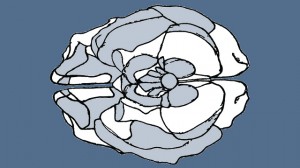
Artwork by Sophia Malandraki-Miller
Henry Molaison has the dubious honour of being the most famous amnesic ever. As a psychology student I know him by his initials, H.M. and have learned a lot about what he has taught us about memory. But I’ve always been curious about who the actual Henry Molaison was and what it was really like for him living without memory.
Henry Molaison was born in Hartford, Connecticut and suffered from severe epilepsy, with the seizures becoming so unbearable that he turned to surgery. Therefore, in 1953, when Henry was 27 years old, his surgeon William Scoville took the radical decision to remove both of his medial temporal lobes, large structures in the centre of the brain. This stopped the seizures, but it also left Henry with an unanticipated side effect: severe amnesia, with Henry losing his old memories (retrograde amnesia) and unable to form new long-term memories (anterograde amnesia). He couldn’t remember the nurses and doctors who treated him every day, forgetting them even if they left the room for a few minutes.
Neuropsychologists studied H.M.’s problems for years, greatly advancing our understanding of memory. But H.M.’s spared abilities tell us almost as much about memory as his deficits. He had ‘pure’ amnesia, with no psychiatric or intelligence problems. His very short-term memory was intact and he could also form implicit memories: for example, after several practice sessions H.M. improved at mirror drawing (in which he had to draw a star, but could only see his hand in a mirror), despite never remembering the practice sessions! No-one knew before H.M. that memory could be subdivided like this.
Any psychology student can give a list of what H.M. tells us about memory. But lectures don’t focus on what it was like to be him. Henry Molaison once remarked, “Every day is alone in itself, whatever enjoyment I’ve had, and whatever sorrow I’ve had.” To me, this captures something poignant about what it was like to be H.M., and also some of his intelligence and insight into his condition. H.M. raises some interesting questions about the self. Despite the loss of most of his memory, he still had a personality (though of course it may have been different from his personality before his surgery). Henry was always polite and friendly to people he met at the care homes, and was always pleased to carry out the experiments he did.
However, H.M.’s temperament may also have been affected by the lack of another brain structure: his amygdala. There is an amygdala on each side of the brain and both amygdalae are located deep within the medial temporal lobes. They are the ‘emotional centres’ of the brain. Having no amygdalae meant that H.M. never really felt sad and hardly ever got angry. He did seem to be able to feel happiness, in that he still smiled and laughed. When he was asked by Suzanne Corkin (a researcher who studied H.M. for much of his life) if he was happy, he replied “Yes. Well, the way I figure it is, what they find out about me helps them to help other people.” He was obviously a kind person. He must have been a different person after the surgery, but it might not necessarily have been because he lost his memories – he could have lost his emotions instead. And it might not necessarily have been for the worse: was Henry’s quality of life better with the seizures or without his memories?
Having been cited in thousands of articles and advancing the field of cognitive neuroscience, Henry Molaison died in December 2008, aged 82. But H.M.’s story continues even in his death. His brain is now being investigated, so he is still telling us about memory. But we should also remember the human side of his story. This is being told in some places: Suzanne Corkin recently published a book about H.M., but there are many other patients with untold stories. Psychology has learned a lot from patients with brain damage, but we sometimes don’t consider what it’s like to live with their conditions. From what I’ve read about Henry Molaison, I think that he would be pleased with the service he’s given to neuroscience. From now on, I will remember H.M. not just as an interesting amnesic patient, but as Henry Molaison, an interesting person.
![Henry Molaison’s unforgettable contribution to neuroscience Henry Molaison has the dubious honour of being the most famous amnesic ever. As a psychology student I know him by his initials, H.M. and […]](/wp-content/uploads/2013/10/H.M.amnesic-colored_blue-620x300.jpg)